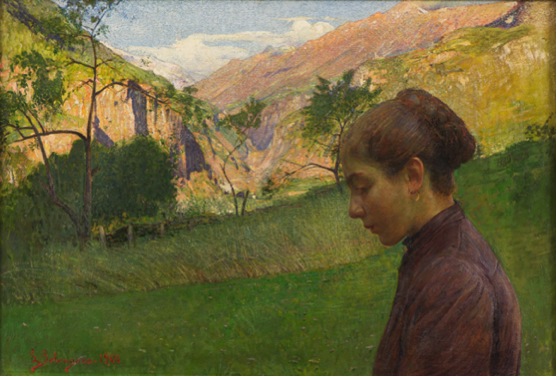
Fanciulla a Varzo, 1901. Luigi Bolongaro
Ritornare alla natura
Nella composizione di Bolongaro con la figura di fanciulla ambientata nel paesaggio della val Divedro troviamo, laddove lo sguardo indugia sull’emozione del paesaggio, il nostro senso di appartenenza alla natura. Tale sentimento di affiliazione è proprio delle diverse culture umane, che ci porta ad un legame filiale con la terra madre, alle relazioni affettive e cognitive che instauriamo con il mondo biotico e abiotico di Gaia (il Pianeta come tessuto relazionale), all’interdipendenza di tutte le cose all’interno del mondo naturale. Un legame ben colto da Antonio Massara, fondatore del Museo del paesaggio in un suo scritto del 1909 ai lettori della rivista Verbania: “In nessuna età come nella nostra, inquieta e variabile, si è sentita più profondamente la misteriosa affinità che lega l’anima umana al paesaggio …”.
La biofilia, termine coniato nel 1984 da Edward O. Wilson, biologo dell’Università di Harvard ed entomologo, ci riferisce proprio della predilezione degli esseri umani per gli ambienti naturali, del legame istintivo con la natura e con gli organismi viventi con cui condividiamo il nostro pianeta, da cui siamo sempre dipesi per la nostra sopravvivenza. E.O. Wilson ha teorizzato che, poiché abbiamo trascorso la maggior parte della nostra storia evolutiva (tre milioni di anni e centomila o più generazioni) nella natura prima di iniziare a formare delle comunità o costruire città, noi proviamo un amore innato per i paesaggi naturali. Da qui il nostro cercare la natura ed il suo potere rigenerativo.
Girl in Varzo, 1901. Luigi Bolongaro
Return to Nature
In Bolongaro's painting with the figure of a girl set in the landscape of the Divedro valley, where the gaze lingers on the emotion of the landscape, we find our sense of belonging to nature. This feeling of affiliation is typical of different human cultures, which leads us to a filial bond with Mother Earth, to the affective and cognitive relationships we establish with the biotic and abiotic world of Gaia (the Planet as a relational fabric), to the interdependence of all things within the natural world. A bond that Antonio Massara, the founder of the Landscape Museum, clearly captured in a 1909 letter to the readers of the magazine “Verbania”: "In no age has the mysterious affinity that binds the human soul to the landscape been felt more deeply than in our own, restless, constantly-changing age, ..."Biophilia, a term coined in 1984 by Edward O. Wilson, a biologist at Harvard University and entomologist, refers to the tendency of human beings to be drawn towards natural environments, the instinctive bond with nature and with the living organisms with which we share our planet, on which we have always depended for our survival. E.O. Wilson theorised that we have an innate love of natural landscapes because we spent most of our evolutionary history (three million years and one hundred thousand or more generations) in nature before we began forming communities or building cities. Hence, we seek out nature and its regenerative power.

